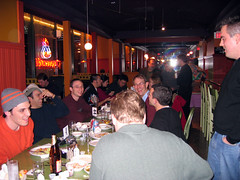“Maven” blogs (the maven moniker shamelessly stolen from the Malcolm Gladwell book The Tipping Point) are business blogs that highlight an individual’s expertise in a particular area.
Contrast these to the “Tour Guide” blogs mentioned earlier in this series. Where the tour guides are showing an inside view of the company, the mavens are putting their expertise out there for readers to discover. Want to know about the latest trends in PR? You’ll likely trip across Steve Rubel in short order. Want to know about wikis and collaboration? Ross Mayfield is your man.
The most interesting thing about the maven business bloggers is that, typically, the blogs are centered around a business area or concept, and are not focused on the blogger’s employer or associated organization. Instead of being directly tied to the corporation, the blog is tied to the individual. The assumption is, if you are an expert in your field and provide a reason for readers to frequent your blog, then you will be “top of mind” when a particular reader is looking for someone to help him or her with a particular business need in a related area at some time in the future. Most of the examples of mavens shown here are in “services”-oriented fields — PR, marketing, consulting, etc. — areas where the individual’s ability to contribute has a direct impact on the final result of an effort.
“Maven” example #1

Blogger: Steve Rubel
Area of Expertise: PR
Company: CooperKatz
Blog Location: http://www.micropersuasion.com
“Maven” example #2

Blogger: Johnnie Moore
Area of Expertise: Marketing & Branding
Company: The Clarity Partnership
Blog Location: http://www.johnniemoore.com
“Maven” example #3

Blogger: Carolyn Elefant
Area of Expertise: Solos and small law firms
Company: The Law Offices of Carolyn Elefant
Blog Location: http://www.myshingle.com
“Maven” example #4

Blogger: Russell Beattie
Area of Expertise: Mobile Technology
Company: Independent consultant
Blog Location: http://www.russellbeattie.com
“Maven” example #5

Blogger: Ross Mayfield
Area of Expertise: Wikis and collaborative technologies
Company: SocialText
Blog Location: http://ross.typepad.com




